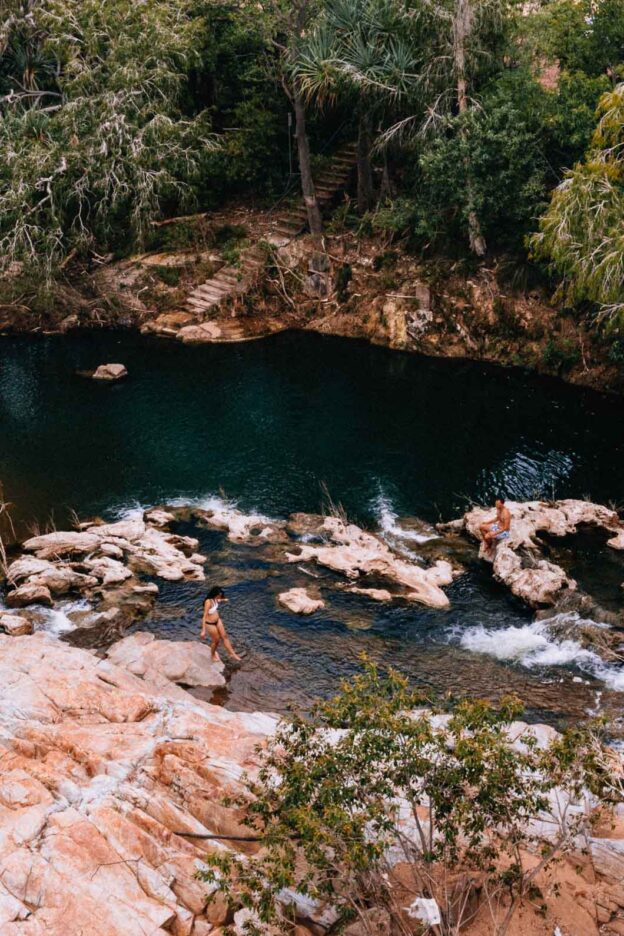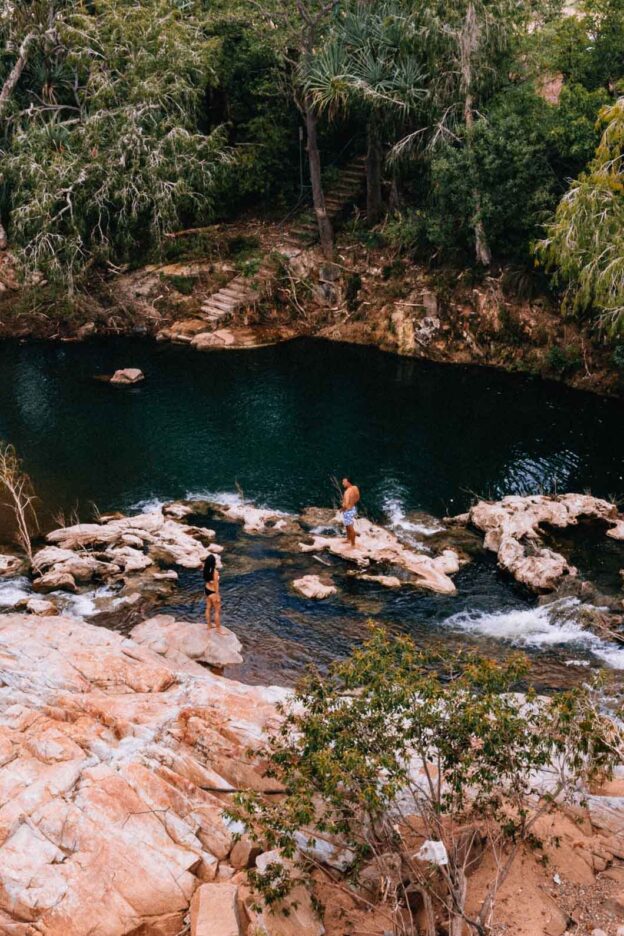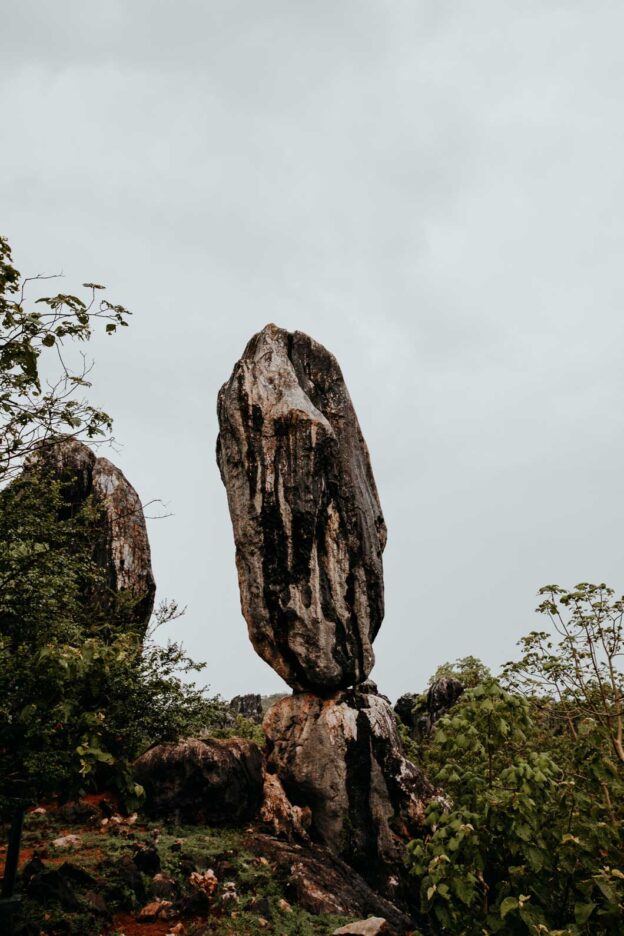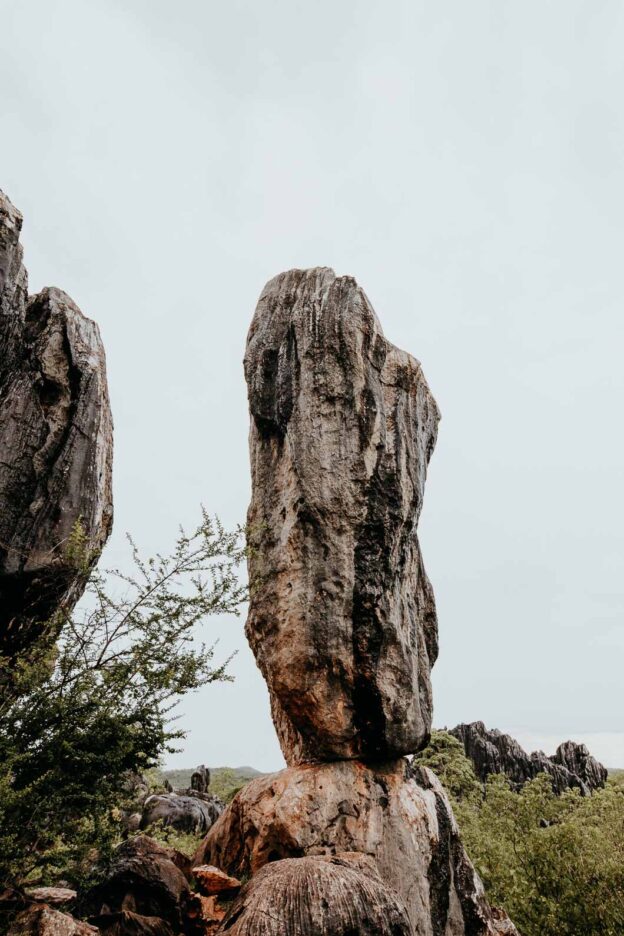CITY GUIDE
This beautiful body of water sits on the edge of town tucked behind the tiny Chillagoe Airport. It’s not an obvious spot; we’d recommend turning onto Weir Road from the intersection of Frew Street and Aerodrome Road. The road turns to gravel. On your left, there will be plenty of trees lining the bank of the creek and eventually you should spy a picnic table. Look for the concrete stairs which lead down to the Chillagoe weir.
If you’re keen to set up a picnic or chill out by the bustling creek, find a path through the trees and cross the shallows to the sandy bank instead of swimming across. The water is wonderfully warm and the locals informed us that there are no crocodiles at the swimming hole.


The township of Chillagoe was once an ancient coral reef. Over time, the reef turned into the incredible limestone bluffs we see today, forming the incredible underground network of passages and caverns. To support the local Indigenous community, book a guided tour with a National Parks ranger to learn more about the significance of the caves to the traditional owners of the land.
Some caves are freely accessible to the public and visitors can take self-guided tours. If you do choose this option, ensure that you read the guidance relating to the cave you wish to visit. There are some underground caves that should not be entered unless visitors have substantial caving experience and are well equipped. Several bat species, pythons and insects occupy and breed in the caves; watch where you step in the dark! And visit respectfully. Aboriginal paintings and rock art sites can be viewed within several caves. Do not touch the rock imagery to prevent irreparable damage.
Popular caves such as Donna, Trezkinn and Royal Arch require a guided tour with a ranger so if there’s a particular cave or section you’re looking to explore, we’d recommend this option. Tours run daily (except Christmas Day) and can be booked at Chillagoe Hub Information Centre.
If you are using Cairns as your base for visiting Tropical North Queensland, you could also consider this tour option as an alternative for visiting Chillagoe.
The name says it all. From the Balancing Rock car park, it is an upward circuit loop (440m return) to the large, phallic (or bean shaped) limestone outcrop that appears to precariously balance at the top of the pathway.
If you’re already exploring the area, you can also walk to Balancing Rock from the Donna car park (2km return). This track will take you through open woodlands featuring eucalypts and ironwoods and you’re likely to spy kookaburras and wallabies.


Close to Chillagoe weir, you’ll spy a tall chimney, remnants of the former ore smelter. The remains are now a drive-through museum featuring a viewing platform and placards detailing aspects of the smelter’s history, safety and other technical information.
It will be a brief walking tour to see the Railway Station, Bank Vault, Court House, Dave the Elasmosaur, Police Museum, Post Office and Post Office Hotel.
A mixture of air-conditioned family rooms, Queens rooms and camping sites, pets are also welcome in some rooms. The observatory is open from Easter – September (weather dependent).
The historic Chillagoe post office built in 1906 has been converted to a guesthouse with rooms or units available to accommodate large or small groups of visitors. Well equipped kitchens and complimentary Wi-Fi.
Inspired by 19th century miners’ huts, these self-contained cottages will make you feel as if you’ve stepped back in time. Modern comforts include ensuites, kitchen facilities and digital television.
Chillagoe is 215 kilometres west of Cairns. Once a thriving mining town known for its range of marble and mineral deposits, the rural town located in the Shire of Mareeba, now only runs a small zinc mine and some marble quarries. The population hovers around 200 with tourist visitation highest between April and October.
All but 20 kilometres of the road to Chillagoe is sealed so take care when driving over the unsealed passages. There are also sections of unfenced roads so beware of wandering cattle and horses.


